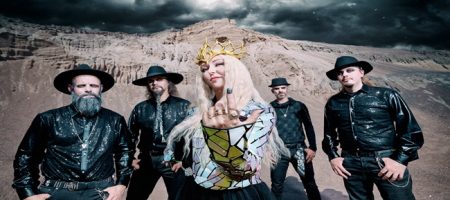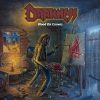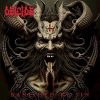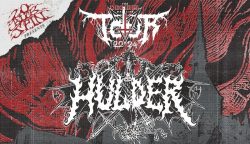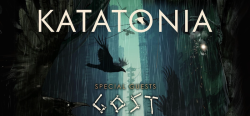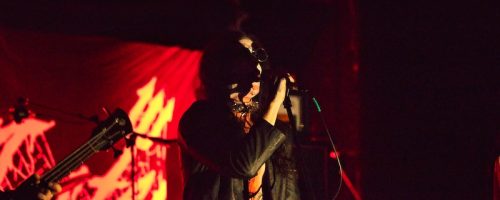Epica – Holographic Universe
Thursday, 29th September 2016
If there was a band that perfectly personifies their name, it’s Epica. Through the years, they’ve added more and more layers and influences to their sound, which seems to grow more and more “epic” with each release. Nothing has changed in that regard with their soon to be released album, The Holographic Principle. Recording everything in-studio has given the band an even larger sound, and the balance of aggression and beauty continues to give the band freedom to explore their direction.
A busy 2016 for the band, who started things up with a US tour in January before going into the studio for The Holographic Principle. Now the band is set to hit the road again with the album’s arrival, including a trip back to the States to conclude their year. We grabbed guitarist Mark Jansen to chat about cutting down the song list (they had 27 ready to go before they hit the studio), Epica action figures, and some of the concepts of the new album.
Dead Rhetoric: Was there a certain level of freedom having some many songs at the ready when you went into the studio for The Holographic Principle?
Mark Jansen: For sure – it gave us a feeling of satisfaction. It put us at ease. When you have a lot of material to choose from, you don’t have to stress over writing more songs because you have to make a deadline. So the only stress we had was what we put on our own shoulders – which was making a great album. That’s a good thing about Epica – we are still hungry to make a great album and we keep each other motivated and on top of the game to make that happen. Sometimes we can be harsh and demanding to each other but it’s all for the purpose of creating an album that we can be very proud of afterwards.
Dead Rhetoric: Did it get tough to decide which songs would be cut and which ones you were going to record?
Jansen: It’s always difficult, but from the 27 songs we had, we first made a selection of 24 that we would rehearse. Once we rehearsed and polished them, we made a selection of 18 songs we would record in the studio. These tracks were recorded and mixed. Then we made another selection of 12 tracks that made it onto the actual album. We still have 6 songs leftover that didn’t make it to the album, but I think they are really great songs. We have to see what we are going to do with them. Next to the 6 ones recorded, we have songs that were not recorded that might make their way to the next album, or a new version – there’s always something that can happen with them. They weren’t written for nothing [laughs].
Dead Rhetoric: As you continue to evolve as a band and bring in more influences over time, do you think Epica has a limitless possibility in regards to shaping an album?
Jansen: We are always looking for things to improve on. With The Quantum Enigma, there wasn’t much left that we thought we could push to another level. One of the things we wanted to do though, was to record all of the orchestra parts live. Last time we had used samples for brass, for example. This time we invited people to record in the studio for real. I think the sound really benefits from that. Even though we used live strings and choirs on The Quantum Enigma, this time every melody we came up with, we found people to play in the studio. All of the percussion and ethnic instruments were played live. With every album you find something that can improve and sound better than before. Whenever we have a feeling that we can do something better, it keeps us going.
Dead Rhetoric: With everything being recorded live in the studio, how do you think the sound will transition when you start playing on tour?
Jansen: On tour we will work like we always do, with the choirs and orchestra on the backing track. Of course, our keyboard player plays as much as he can himself, but he cannot play all of the orchestra stuff by himself. The best would be, if we could, in the near future – play with a full orchestra. It’s a dream that we have realized two times in our career. But now, more than ever, it’s a new dream to do more shows like that. Hopefully we can realize that.
Dead Rhetoric: Lyrically, much of your more recent material is based a lot on science. Where’d your interest in science come from?
Jansen: I studied psychology and was on my way to being a psychologist. I graduated but didn’t really continue on to becoming a scientist, but that could have been the case if music didn’t work out for me. That’s where my interest in science comes from.
Dead Rhetoric: Could you go into some of the major concepts in The Holographic Principle?
Jansen: What fascinates me most, and on The Quantum Enigma we looked into the quantum enigma – that when you investigate something on the quantum physics level, that you infer what you try to look at, and there’s no other way around that you know how things look like when you are not observing. That’s very interesting – it sort of means that our consciousness has a direct influence on everything around us. With The Holographic Principle, we dove even further into the material. I watched some lectures from Leonard Susskind and it really fascinated me about the holographic principle theory. It says that everything around us might be an illusion – a hologram in fact.
That really sounded wicked to me in the beginning, and thought that it could not be the case. But once you start looking deeper, with an open mind, you start realizing it might be the case. Especially when you look at virtual reality. They can already build worlds where you can dive into them and get lost in them. If this technology continues to develop, sooner or later we will put on a mask/suit and we are completely in a different universe that feels exactly the same as this one. Then you can realize that maybe this [world] is a virtual reality all on its own. That it’s just a layer of a higher reality that we just don’t have access to at this moment.
Dead Rhetoric: You mentioned research – when you are doing a concept like this, is it important that you look into it to give it a more genuine feel?
Jansen: Definitely – you need to look into it and see what people have said about it, and even the mathematics underneath. I don’t understand all of the mathematics behind the principle, but at least I can explain it in a way that I understand. But because I’m not that closely connected to the investigations of this topic, maybe I can look at it as a more broad view and come up with interesting thoughts as well. That’s also what I notice when I talk with fans about these topics. They come up with good ideas that I haven’t thought of myself. That’s something that’s fascinating to me – that together you can come to new conclusions and new openings for further investigation. We write something, and people can do with it whatever they want.
Dead Rhetoric: There was an extensive documentary that was released – do you feel that the fans crave to know a lot about the creative and recording process for your work?
Jansen: Yeah, you notice that people are more demanding in modern times. It’s not so easy to stand out anymore. We feel like we have to use the modern technology in order to make ourselves visible in this field of thousands of releases each month. We try to do whatever we do in a professional way. I think in this way, it makes us more visible and people like the look behind the scenes. So it’s fun for the fans, and it’s a nice way for us to be able to say that we are coming out with a new release.
Dead Rhetoric: The “E” logo seems to change over time. How did you come to the current iteration of the “E” logo?
Jansen: It’s based on the ouroboros symbol of the snake biting its own tail. That is part of the lyrics to “Universal Death Squad.” So we decided to represent the E in a slightly different form. We made a few designs and this one came out the best. Every time we try to do something a little different and give something new to an existing idea – refresh it, so to say.
Dead Rhetoric: Kind of continuing with presence and visibility, where did the idea of having Epica action figures stem from?
Jansen: That was actually an idea from our manager. He said let’s do something crazy. We were all laughing aloud when he came with that idea, but he convinced us and said it was something unique and we should give it a try. It’s something nice for the die-hard fans. There was this company that came over while we were on tour and they brought a 3D printer. We went in it and they made some pictures from all sides and created the figures.
The funny thing was that I got it sent to The Netherlands. I live in Italy, but I still have my post address in The Netherlands where my parents live. I got it there and opened it, and it was funny – I put it back in the box and I hid it somewhere. The next time I was there…I don’t know how she found it, but she put it in the middle of the room. She must have looked into the box and found this action figure, without me even telling her that they existed so she must have been very surprised. I was standing in the middle of their room, and they are proud of me, so that’s a good thing. For me though, it’s strange to see myself as such a small version, standing on the table [laughs]. It’s a nice thing!
Dead Rhetoric: That’s funny, I was going to ask if you thought it was strange to see an action figure of yourself, as they are normally reserved for movie stars and cartoons…
Jansen: It was very strange yes. You see that it’s really correct – everything that I looked like that day when I did the photoshoot. All of the details are there. You look at yourself and you can turn yourself around and see the back of you, where you never see yourself. That’s quite funny!
Pages: 1 2












